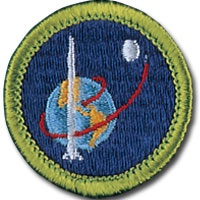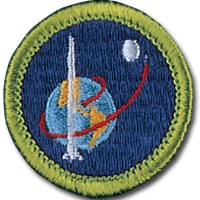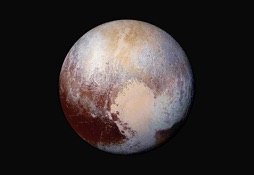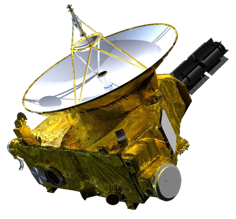New Horizons
Mission Overview






Space Exploration Merit Badge Supplementals
(created Thr., Feb. 21, 2019, updated Wed, Nov. 13, 2019)
This is an extension of
the Space Exploration Merit Badge page.

The New Horizons
Mission to Pluto
♇
image source:
https://en.wikipedia.org/wiki/New_Horizons
This page provides insights about NASA’s
New Horizons mission to Pluto and the Kuiper Belt.
The information on this page is NOT required for the Space Exploration Merit Badge.
The information on this page is shared to provide additional insights into the exploration of Pluto and to encourage enthusiasm about all that is exciting about the exploring the universe beyond our planet, in person and through unmanned spacecraft.

Pluto...
-
-Our ninth planet, discovered in 1930, ...
-
-“demoted” in 2006,
(through what appears to have been a personal dislike for Clyde Tombaugh) ... -
-and now properly recognized as a third category of planets...
-
-1) rocky planets like the inner planets Mercury, Venus, Earth and Mars
-
-2) gas giants like Jupiter, Saturn, Uranus and Neptune
and -
-3) dwarf planets like Pluto and Eris, which are smaller and likely far outnumber all other planet types.
-
-Yes, there are different kinds / types of planets, just like there are different kinds / types of stars... with their own wide variety of sizes, colors, temperatures, etc.
-
-has been visited by NASA’s New Horizons spacecraft.
This group of pages is dedicated to sharing all the interest and excitement of what it took to learn what we now know about Pluto... knowledge gained by the strong dedication and commitment of the New Horizons mission team and all who supported them in their efforts.efforts.

This specific page provides background about the New Horizons mission.
This specific page has four sections:
-
1.Planet definition, from Merriam-Webster dictionary
-
2.Brief history of planetary discoveries
-
3.Kuiper Belt objects (KBOs), Oort Cloud, IAU Planet definition refinement and Pluto’s demotion
-
4.“An organically grown planet definition,” as published in Astronomy magazine by New Horizons Principal Investigator Alan Stern


image source: http://www.nasa.gov/mission_pages/newhorizons/main/index.html
A Very Brief History of Space Flight from Sputnik to New Horizons
-
-The USSR launched Spitnik in October, 1957 and the space race was on.
-
-The USSR launched the first man and woman in space, but the US is the only nation to set foot on the moon... 24 feet... from 12 astronauts
-
-As we looked to the planets, we realized that the 1970s-1980s provided a once-every-175 year opportunity for the planets to line up and make it easier for spacecraft to visit the outer planets.
-
-Voyager 1 was supposed to visit Pluto but we wanted it to explore Titan more, so it did explore Titan closer, but that changed its course so it did not go to Pluto.
-
-The U.S. Postal Service issues a stamp series commemorating the spacecraft that visited each planet... Pluto was noted as “Not Yet Explored” and that inspired Plutophiles to get a mission to Pluto.
-
-It took from 1989 until 2015, but the team led by Alan Stern, headquartered at Johns Hopkins Advanced Physics Laboratory (APL) won the contest to build the New Horizons spacecraft and get us to Pluto...
... and their New Horizons mission was better than everyone ever hoped for... and expectations were high!
A Brief History of Space Flight
Space Exploration had been the stuff of imagination until 1957. On October 4, 1957, the USSR launched the first man-made satellite Sputnik. The U.S.A. then launched Explorer 1 on January 31, 1958.
The Space Race expanded through the Soviets sending the first man and woman into space, and the US catching up through the Mercury, Gemini and Apollo programs and still being the only nation to land a person on another celestial body... from Apollo 11 through Apollo 17, 12 astronauts walked on the moon and six remained orbiting in the command module.
In the early 1970s, NASA expanded exploration with space probes, to Mars and Venus. It was also realized that the motions of the planets line up every 175 years and that this rare occurrence was happening right then, the 1970s-80s. This meant any one spacecraft could visit multiple, and possibly all, of the outer planets.
This led to Pioneer 10 & Pioneer 11 and Voyager 1 & Voyager 2 (see also NASA’s Voyager page) exploring the outer planets.
Pioneer 10 explored Jupiter for the first time.
Pioneer 11 explored Jupiter, and then Saturn for the first time.
Voyager 2 explored Jupiter, Saturn Uranus and Neptune.
Voyager 1 explored Jupiter and Saturn, and because it was desired for it to perform more thorough exploration of Titan, its trajectory prevented it from proceeding to visit Pluto. As noted in “Chasing New Horizons,” “Picking Titan over Pluto was a food, and logical, choice. And even today, no one regrets this decision, especially now that Titan has proved to be a world of wonder with methane clouds, rainfall and lakes, and vast fields of organic sand dunes - truly one of the most enticing places ever explored. It was indeed the right decision, but it also closed the door on humanity’s chance for a visit to Pluto in the twentieth century. If Pluto were ever to be visited, it would be left for another time, and another generation.” (“Chasing New Horizons,” p. 14)
Voyager 2 explored Jupiter and Saturn, and then was the first spacecraft to visit Uranus, in 1986, and the first to Neptune, in 1989.
This image, from The Planetary Society, shows the trajectories of these four spacecraft:
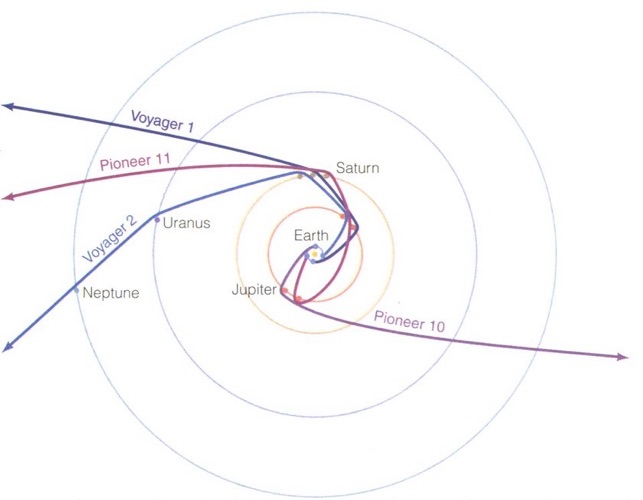
source: http://www.planetary.org/multimedia/space-images/charts/pioneer_voyager_paths.html
Postage Stamp Sparks Pluto Mission
After Voyager 2 visited Neptune in 1989, the U.S. Postal Service designed stamps to commemorate the first spacecraft to visit each of the planets. You can see the stamps at this site: https://arago.si.edu/record_192129_img_1.html.
Pluto’s stamp noted “Not Yet Explored,”
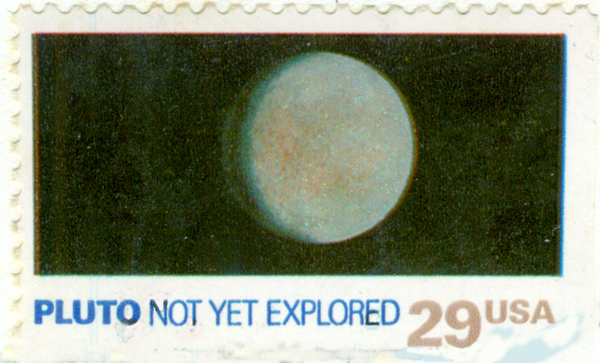
...which became a motivation for the New Horizons team.
More about the history of space exploration can be found on this Encyclopedia Brittanica article - https://www.britannica.com/science/space-exploration/From-Sputnik-to-Apollo.
A Brief History of the New Horizons Mission
It took 26 years to get to Pluto... from a group of “Plutophiles” having an idea in 1989 until the New Horizons flyby on July 14, 2015.
A Summarized History of the New Horizons Mission History, 26 years from idea in 1989 to Pluto flyby in 2015...
Initial Idea
-
⁃1989 - at the annual American Geophysical Union meeting in Baltimore, MD, the AGU hosts its first-ever Pluto session - more than a hundred scientists attend the session and generate excitement about Pluto
-
⁃1989 - the week before the AGU meeting, New Horizons Primary Investigator Alan Stern asks Dr. Geoff Biggs, NASA’s Director of Solar System Exploration Division, to fund a study of how to plan a mission to Pluto
-
⁃1989 - One night during the AGU meeting, at an Italian restaurant in Baltimore, several scientists discussed many ideas about what it would take to send a mission to Pluto... all “shared that a Pluto mission was an important idea that somehow needed to happen.” (p. 36) - this became a pivotal night...
-
⁃1989 - A letter-writing campaign to NASA leads to Briggs funding the “first official NASA study of a possibly Pluto mission,” and asked Alan Stern and Fran Begaenal, to be the lead scientists.
-
⁃1990 - the team delivers the results of their study, “Pluto 350,” which “focused on a small, 350-kilogram spacecraft weighing about half what Voyager had.” This approach would lower the costs, making it more appealing for approval.
Many Proposals, a decade of NASA “complications”
-
⁃1990-2000 - The team completed multiple studies and created many proposals for missions to Pluto, adjusting to the changed requests from NASA… changes that seems to intentionally stall the program by asking for something new each time.
Final Proposal and Selection
-
⁃2000 - NASA finally confirms plans to move forward with a Pluto mission, but instead of awarding to the existing team, they opened the competition, which let the JPL / Jet Propulsion Laboratory to also propose.
-
⁃2000 - Alan Stern and team partner with the APL, the Johns Hopkins University Applied Physics Laboratory, and are the underdog in the competition.
-
⁃February, 2001 - weeks after the initial Pluto proposals are delivered, NASA’s budget shows $0 for Pluto, and instead, funding for a mission to Jupiter’s moon Europa; speculation is that the JPL knew they did not win the Pluto mission and did not want the APL to win it.
-
⁃September 11, 2001 - 9/11 tragedy
-
⁃September 18, 2001 - final Pluto proposals are delivered
-
⁃October 16, 2001 - NASA site visit to APL for in-person presentation
-
⁃late November, 2001 - NASA calls Alan Stern and shared “Congratulations. We’ve selected New Horizons to be our Pluto mission.”
More NASA “complications”
-
⁃the next date, November, 2001 - letter from NASA to APL team 1) re-confirms the selection for New Horizons, 2) confirms the launch date and states that no cost overruns will be tolerated, and 3) moves the launch from 2004 to 2006 (which would extend the project two years, but could not consume more funds)
-
⁃February, 2002 - Pluto mission cancelled “due to cost overruns,” which was not true. Senator Barbara Mikulski from the Appropriation Committee for NASA led effort to commit funding for one more year. That funding was made dependent on New Horizons being the Top Pick / the #1 pick of the upcoming Decadal Survey… which was a “new, once-in-a-decade review of all of NASA’s planetary mission priorities… agree on a consensus ranking of priorities for which missions are to be funded and launched for the entire decade to come.” New Horizons needed to top that list.
-
⁃March, 2002 - early 2003 - the New Horizons team was ready to “win big or go home…” part of the team worked tireless to design the spacecraft while the other half of the team waged “an intensive campaign to make the case why the exploration of Pluto and the Kuiper Belt should be the very highest priority of the Decadal Survey.”
-
⁃early, 2003 - New Horizons wins the Decadal Survey but receives the stipulation that they must add components to the spacecraft that increased costs and timeline and hurt the mission’s goals.
-
⁃Spring, 2003 - NASA removed the stipulation to add the additional components and the New Horizons team could finally proceed with the mission they had planned.
Building the Bird through Launch
-
⁃2003-2006 - build and test the spacecraft
-
⁃January 19, 2006 - New Horizons launch, from Cape Canaveral
Jupiter Flyby
-
⁃January - June, 2007 - Jupiter flyby… provided gravitational assist, to speed New Horizons to Pluto more quickly… and provided a dry run of the Pluto mission… the spacecraft’s equipment performed observations of Jupiter similar to those they would perform at Pluto.
Hibernation
-
⁃From 2007 to 2014, the spacecraft was mostly in hibernation mode, periodically being “woken up to be thoroughly checked out, to conduct instrument calibrations and en route scientific observations, and, from time to time, receive software upgrades to correct bugs or add new capabilities.”
Pluto Flyby
-
⁃July 14, 2015… success
Ultuma Thule Flyby
-
⁃December 41, 2018… success
All quotes are from “Chasing New Horizons”
http://pluto.jhuapl.edu/Mission/The-Path-to-Pluto/Mission-Timeline.php
Liftoff!
“Liftoff of the New Horizons spacecraft aboard an Atlas V rocket from Cape Canaveral Air Force Station, Florida, January 19, 2006.”
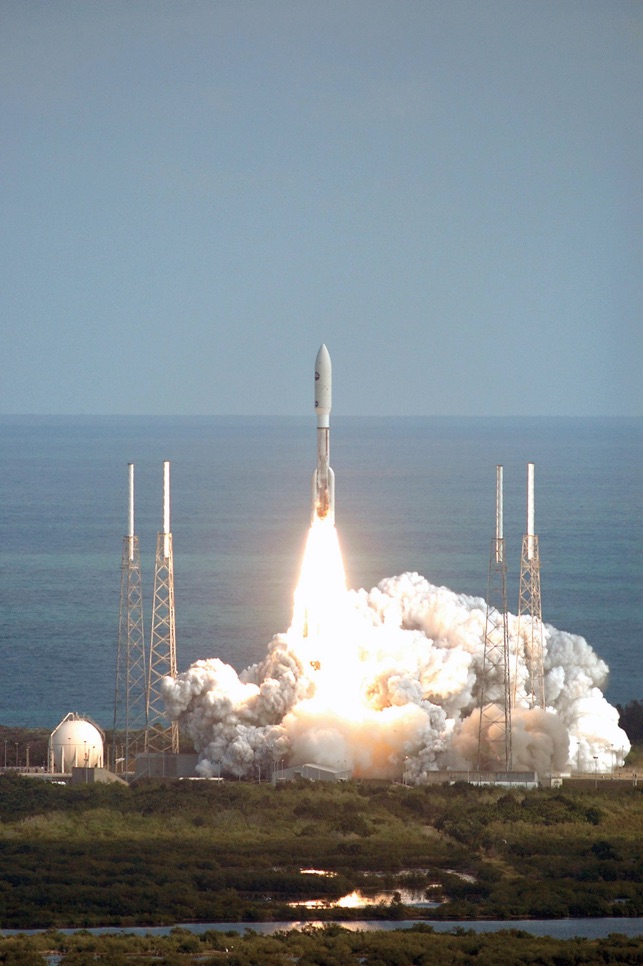
image source: https://www.britannica.com/topic/New-Horizons/media/1081294/84962
After a nine-year journey, which started with the fastest-ever departure from Earth’s orbit - 34,500 mph / miles per hour, NASA’s New Horizons spacecraft flew by Pluto on July 14, 2015.
NASA’s New Horizons page has an amazing wealth of information about our discoveries of the only American-discovered planet / dwarf planet / planetoid / plutoid.
This video was created from images captured by the Hubble Telescope:
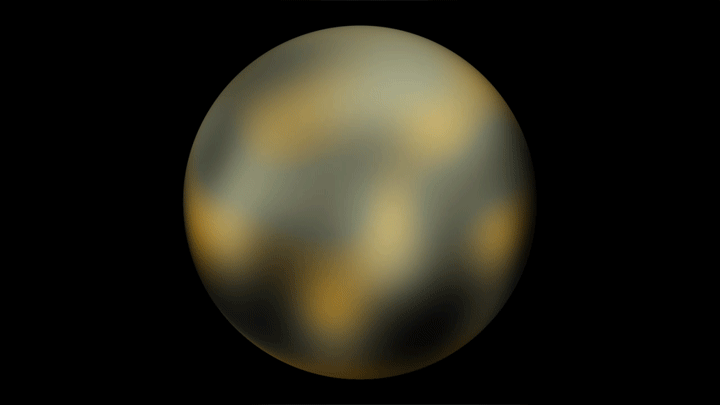
source: NASA, via https://www.npr.org/sections/thetwo-way/2014/12/08/368492457/oh-snap-nasa-promises-best-photo-yet-of-faraway-pluto
In 2016, the U.S. Postal Service honored New Horizons and Pluto with this stamp series:
Pluto - Explored!
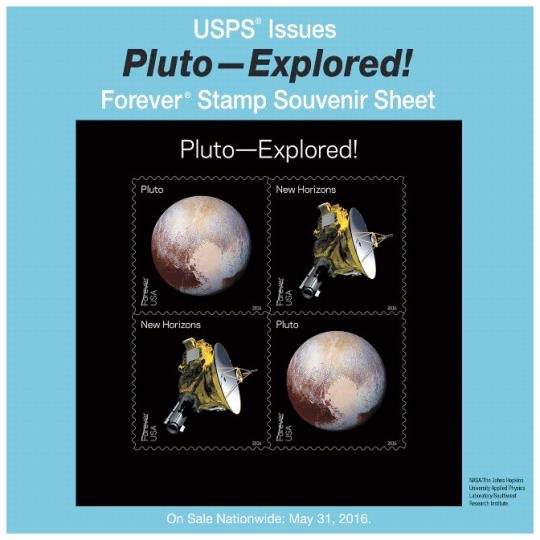
image source: https://about.usps.com/postal-bulletin/2016/pb22448/html/images/bck_cvr_1.jpg
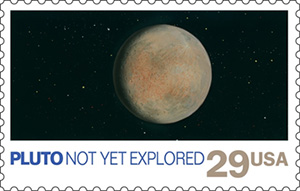
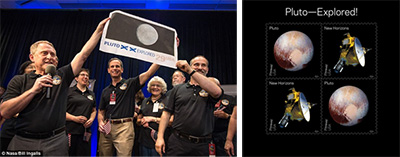
The 1991 stamp that served as the rallying cry for the New Horizons Mission to Pluto is “updated” by members of the New Horizons science team on July 14, 2015, the day the spacecraft reached Pluto. The “Pluto—Explored!” stamps issued May 31, 2016, by the U.S. Postal Service set the record straight. See caption at bottom of news release.

“WASHINGTON — A 1991 Pluto: Not Yet Explored stamp traveled more than 3 billion miles on a spacecraft to the dwarf planet has earned the GUINNESS WORLD RECORDS achievement for the farthest distance traveled by a postage stamp. The stamp also served as NASA’s rallying cry to set the record straight for exploring Pluto.
“This record will extend another 1 billion miles, as NASA recently announced the New Horizons mission will journey beyond Pluto to visit a Kuiper Belt object known as 2014 MU69 — considered to be one of the early building blocks of the solar system.
...
“In 2006, NASA placed a 29-cent “Pluto: Not Yet Explored” stamp on board the New Horizons spacecraft on its way to Pluto and beyond,” said U.S. Postal Service Chief Marketing and Sales Officer and Executive Vice President Jim Cochrane. “That historic flyby with Pluto took place last summer — July 14, 2015, to be precise — after New Horizons travelled more than three billion miles in its nine and a half year journey.” “
source: https://about.usps.com/news/national-releases/2016/pr16_057.htm

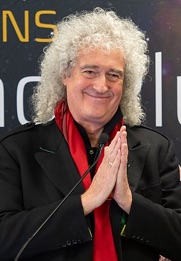
image source: File:Brian_May_(NHQ201812310024)_(cropped).jpg
Bryan May - Guitarist and Astrophysicist
Bryan May is the guitarist for the band Queen. Prior to that, he “studied Mathematics and Physics at Imperial college London, graduating with a Bachelor of Science degree in Physics in 1968 with honours.”
May then became quite successful with the band Queen.
Then, in 2007, “May was awarded a PhD in astrophysics from Imperial College London for work started in 1971 and completed in 2007.”
Source: https://en.wikipedia.org/wiki/Brian_May, section titled “Early life”
May’s doctoral thesis was on the study of “reflected light from interplanetary dust and the velocity of dust in the plane of thee Solar System.”
Source: https://en.wikipedia.org/wiki/Brian_May, section titled “Scientific career”
“Suring the New Horizons Pluto flyby NASA press conference held on 17 July 2015 at Johns Hopkins Applied Physics Lab, May was introduced as a science team collaborator. He told the panel ‘You have inspired he world.’”
May remained involved with the New Horizons Mission.
“On 31 December 2018 through 1 January 2019, May was in attendance at the watch party for the New Horizons flyby of the Kuiper Belt object, 486958 Arrokoth, and performed an updated version of his New Horizons celebratory song.”
Source: https://en.wikipedia.org/wiki/Brian_May, section titled “Scientific career”

The song, on Apple Music:
https://music.apple.com/us/album/new-horizons-ultima-thule-mix-single/1446860588
The song, in Google Play:
Video, on YouTube:
https://www.youtube.com/watch?v=j3Jm5POCAj8
“Queen’s Brian May releases ‘New Horizons’ Single to Celebrate Epic Flyby”
https://www.space.com/42875-brian-may-new-horizons-song-ultima-thule-flyby.html

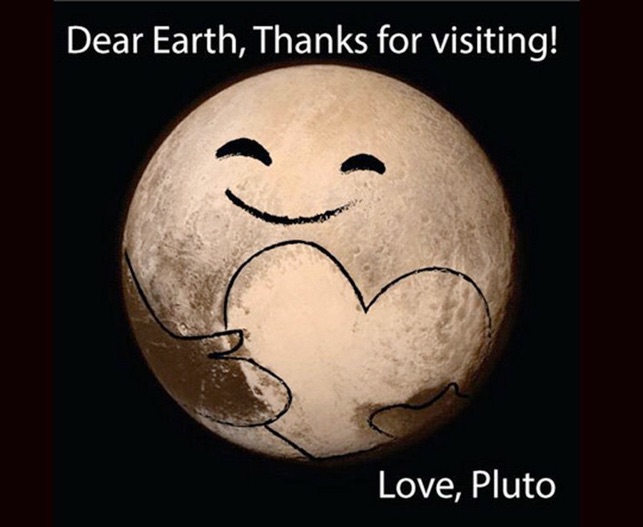
image source: http://cdn.images.dailystar.co.uk/dynamic/122/photos/207000/900x738/261207.jpg
New Horizons District...
Also the name of our Boy Scouts of America - Greater St. Louis Area Council District - the New Horizons District!
A final thought...
All of the first four interplanetary spacecraft - Pioneer 10 & 11 and Voyagers 1 & 2 are now in interstellar space.
“After more than 30 years, it appears the venerable Pioneer 10 spacecraft has sent its last signal to Earth. Pioneer's last, very weak signal was received on Jan. 22, 2003.
“NASA engineers report Pioneer 10's radioisotope power source has decayed, and it may not have enough power to send additional transmissions to Earth. NASA's Deep Space Network (DSN) did not detect a signal during the last contact attempt Feb. 7, 2003. The previous three contacts, including the Jan. 22 signal, were very faint with no telemetry received. The last time a Pioneer 10 contact returned telemetry data was April 27, 2002. NASA has no additional contact attempts planned for Pioneer 10.”
source: https://www.nasa.gov/centers/ames/news/releases/2003/03_25HQ.html
And new Horizons has joined the Pioneer and Voyager spacecraft which are all now outside our solar system.
And while New Horizons is currently the fastest man-made object, it won’t remain that way... if it did it would eventually become the furthest man-made object, but it is apparent that the furthest man-made object will remain Voyager 1 for the foreseeable future.




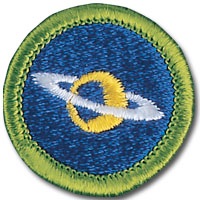
These are all of the links to the Astronomy Merit Badge pages:
Astronomy Merit Badge - Extra “Fun Facts”
Astronomy - Great American Eclipse
Astronomy - Great American Eclipse 2017

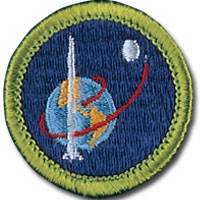
These are all of the links to the Space Exploration Merit Badge pages:
New Horizons - Mission Overview
New Horizons - Pluto Resources


All images were scanned directly from the magazine using the Halo Scanner Mouse - http://shop.halo2cloud.com/collections/computer-and-backup/products/scanner-mouse, which I received as a Christmas present from my mother in 2013.



Regardless your desire to pursue a career in space exploration, it is hoped that you learned enough about exploring space through this merit badge to at least be interested to continuously look up at the sky in awe and wonder, and think about what you may want to explore if you were to go “out there” or were to send a probe “out there.”
If you pursue with enthusiastic interest, that’s great. If you do make a career in the field, GREAT.
May all be better off having completed your Space Exploration Merit Badge than you were before you started.
